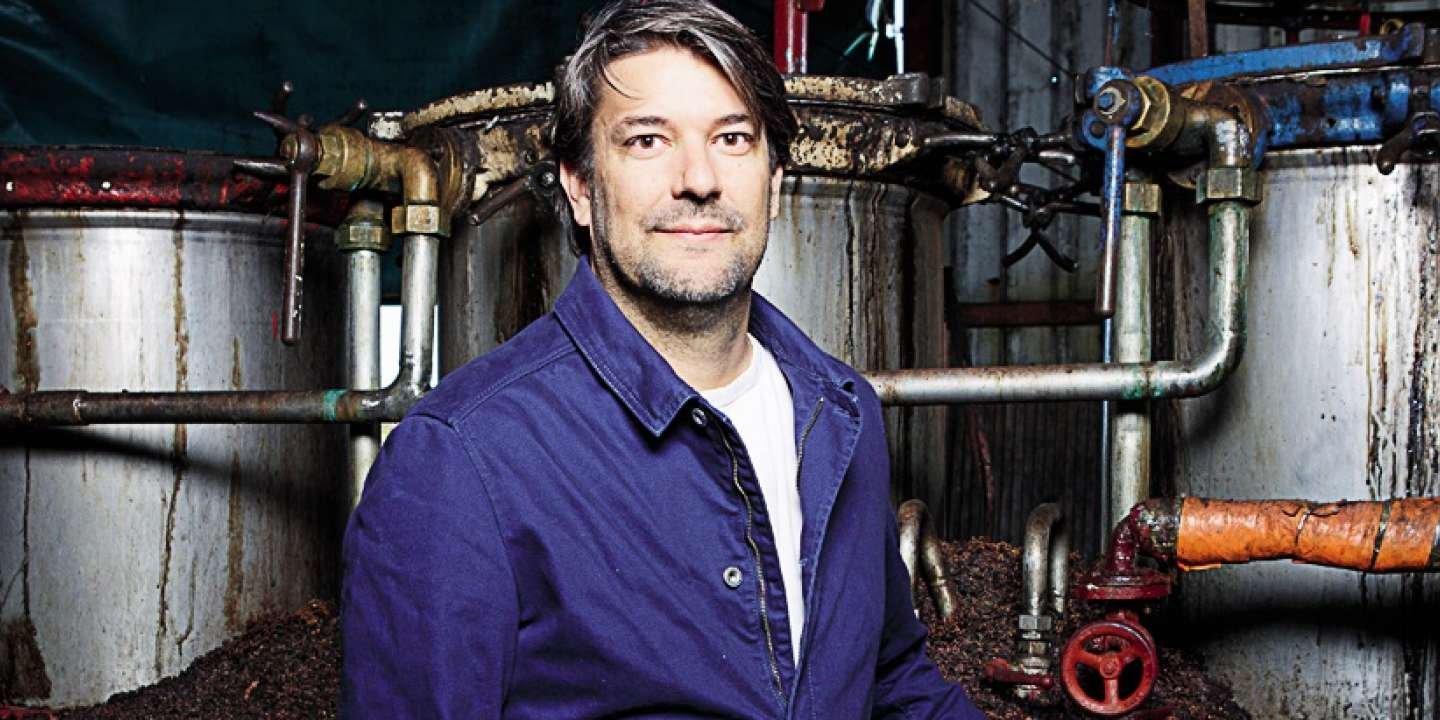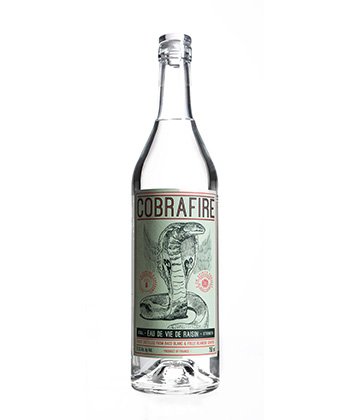Barney Wilczak and his tiny distillery are bottling the wildness of the orchard.
May 12, 2025
“The fruit is coming.”
The urgent phone call that Barney Wilczak anticipates typically comes in the middle of the night. The caller is one of his local farmer partners who has just walked their orchards to touch, smell, and taste the fruit. The brief exchange notifies Wilczak that the quince, perry pears, blood oranges, raspberries, or damson plums destined for distillation are ready to harvest. A distiller of groundbreaking eaux de vie, Wilczak describes his work as being “in service to the fruit.” Part of that service is to represent the fruit at its highest level of flavor, to harness its essence. So the processing must begin right away. Wilczak takes the farmer’s call as his cue, rises in the early darkness, and prepares to receive by the truckload literal tons of fruit.
Wilczak built Capreolus Distillery in 2016, on the same property as his childhood home in Cotswold, southwest England. His eaux de vie have an almost unnerving ability to transport the drinker to those abundant fields. The region is known for its endemic fruits, many of which don’t appear in other parts of the world. The name Capreolus refers to the deer that frequent Wilczak’s garden. “They’re the most beautiful native deer we have and they’re so ephemeral,” he says. “You see them and then they disappear. It felt apt, as we try to capture things that only last for moments.”
That late night/early morning phone call from Wilczak’s farmer collaborator wouldn’t have been a surprise. Wilczak firmly believes that production revolves entirely around the wisdom of the trees and the people who cultivate them, not marketing drives or quarterly sales targets. Every piece of fruit that arrives at the distillery is hand-sorted to check for outliers of “too much softness or spring,” before it is hand-pressed and guided through distillation and bottling.
Hand-sorting gooseberries at Capreolus. Photograph By Barney Wilczak
You might say that Wilczak practices a type of conservation: His farming supports much-needed biodiversity, and drinkers around the world can experience hyperlocal plants they wouldn’t otherwise have access to. The quince evokes notes of cinnamon, fig, and dark cherry. It tastes of earth yet bright twig and leaf—to drink these eaux de vie is to be situated in terrain.
“Last year we spent 7.5 hours sorting 700,000 individual raspberries. That’s 3.6 tons,” Wilczak says, with a look of bewilderment. All that fruit, time, and effort across a team of four people, yielded roughly three hundred 375-ml bottles. With a sense of pride and maybe surrender, he adds, “It’s ridiculous.”
Wilczak has fans, if not acolytes, of his so-called ridiculousness. Among them, famed cocktail bartender Ryan Chetiyawardana, professionally known as Mr. Lyan, who features Capreolus eaux de vie at Seed Library in London’s Shoreditch, Washington D.C. bar Silver Lyan, and Super Lyan in Amsterdam. He credits Dawn Davies of The Whisky Exchange for introducing him to the spirit. “It was revolutionary to try an eau de vie that represents my favorite fruits as a UK native,” Chetiyawardana says. “Barney sees the whole essence of the plant as not just a biological creature, but what it stands for. I was flabbergasted.”
A view of the orchard
Preserving nature in the bottle
Wilczak found distilling through his love of nature. As a student he thrived in botany and biology, but couldn’t make sense of working nonstop in a lab. He pivoted to study photography and specialized in conservation. In brief, he became a plant photojournalist. “I was photographing habitat restoration on six continents, building media libraries for botanic gardens in 118 countries.” Alongside his studies, he developed a hobby for making ciders, exploring the technicalities of distillation and méthode traditionnelle, a style of winemaking that involves a secondary fermentation in the bottle. The leap to distilling was not a huge jump. “It all comes down to a love for plants.”
As he approached age 30, Wilczak experienced “a bit of a life crisis.” He didn’t want to only document plants for visual archives. He wanted to promote the growth and appreciation of those plants for others. “I realized that people are obsessed with varietal differences in wine, but it’s also true of every single fruit.”
When Wilczak launched Capreolus, his bank account was overdraft by eight pounds, but supported by his partner Hannah Morrison, whose taste became imperative to Wilczak’s process. Everything was once done by hand and muscle, though he’s since acquiesced to buying a mill. He committed to work with farmers within a fifty-mile radius of his home-distillery, and just recently purchased meadowland to plant quince trees, which will soon bring that particular eau de vie production within range (it was previously the lone outlier).
His focus on local farmers came down to pay equity. “Early on I was talking to someone in Finland about wild-picked cranberries and they said, ‘We’ll get them to you for 2 euros per kilo.’ I knew that was really really cheap for wild-picked fruit,” he explains. The fruit would be picked in Russia. “What are the labor laws there? What are people getting paid?” Wilczak wanted to work with people he could meet, with operations he could see. “We wanted to pay people a proper wage, focused on farming well,” he says, a nod to the price point of his lineup, which can range from about $90 to $185.
With his local focus, he learned that there was not “a single piece of overlap in flavor or aroma.” The realization inspired him to learn how these individual expressions manifested. He spent about seven years studying fruit distillation practices in epicenters of Austria, Germany, Italy, and France, and translating non-English books on the subject.
After distilling perry pears from 200-year-old 45-foot trees, Wilczak was shocked. The distillation didn’t smell like fruit. “It smelled like sun-warmed bark, ripe and unripe wood, autumnal leaves, and almost like the grass around the trees,” he says. “My self-guided education had a huge focus on a technological, yield-driven way of working, but that robbed the eau de vie of complexity and organic structure,” he continues. “I became interested in making eaux de vie that are truly organic and expressive of where they come from.” That meant becoming dogmatic about respecting the inherent knowledge of the trees and the ecosystems that allowed them to produce such varied fruit. “Suddenly, the eaux de vie started to smell like the orchards.”
Black currant eau de vie in progress. Photograph By Barney Wilczak
Around the world with eaux de vie
In New York City, Jorge Riera, wine director at Frenchette, Le Roc, and the newly revamped Le Veau d’Or, features Capreolus eaux de vie as the finishing touch on leisurely, decadent meals. “It’s mind-blowing,” Riera says. “The delicacy, the finesse, the floral notes that Barney gets out of it. I was blown away.”
Riera first tasted the lineup in 2018 in Vienna, Austria, at Karakterre, a 14-year-old natural wine conference celebrating producers primarily from central and eastern Europe (the festival now has a NYC iteration going into its fourth year). Riera immediately called his importer, PM Spirits, to see about getting Capreolus to the States. “With the raspberry eau de vie, you feel the fuzz of the fruit in the nose,” he goes on. “They work with nature and it’s beautiful. But for me, I see the result at the dining table. I see the emotions from people immediately.”
One of the more evocative eaux de vie is the damson plum, a quintessential British fruit. “Old recipes of distilling damson take on this slightly jammy, tart note,” Chetiyawardana says. “Barney manages to capture the smell of the blossoms as you walk past the bush. It has that white flower elegance. The purple fruit notes encapsulate the tartness of the skin and the yield of the flesh. It pulls through to this wonderful fresh almond note from the kernel.”
For this writer, Capreolus eaux de vie feels like falling into a safe, warm memory you didn’t know you had. The damson plum is an example of Wilczak’s conservation ideology: “No one knows what to do with a cooking plum; it’s something we’ve lost from our vocabulary. We can let these things slip away. But if we want those genetics as a resource given changing climate, we have to give a justification for them to be grown.” His exquisite bottles make for a compelling reason. The only experience better than sipping Capreolus is to share it with someone as willing to be moved as you.



















